 |
SRGC Bulb Log Diary |
| Home Recommend This Site To A Friend |
|
NUMBER 2 7th JANUARY 2004
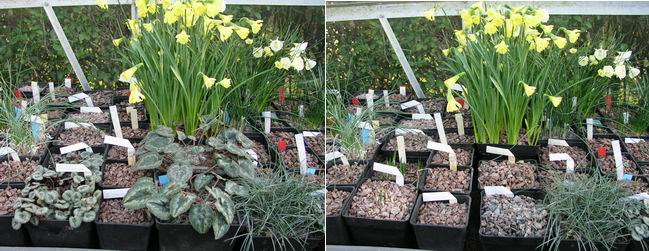
Spot the difference Well, how many of you spotted the difference between these two pictures, all of you I am sure. The cyclamen intaminatum and hederifolium plants seen in the left hand picture have been replaced by some crocus plants. The cyclamen which have finished flowering are now on the lower plunge swapping places with the spring crocus which will prefer the higher light levels of the top plunge as they come into flower. This is a regular juggling act we perform to make maximum use of the space we have and ensure that the plants get the most light when they most need it. 
Bulbs from plunge As I disturb the sand plunge, to move pots around, I keep coming up with handfuls of self sown bulbs. As I have mentioned before I love these strays which come free without the hassle of sowing seed into pots. Tt is also a great way to observe the root systems and underground growth. 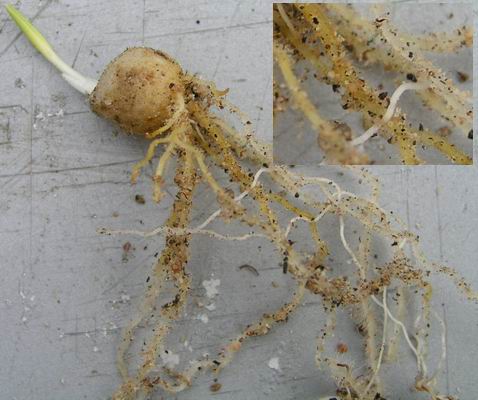
Frit roots Look carefully at the root system on this young fritillaria bulb - note the short, fine hair- like roots all over the main root which will help the bulb extract nutrients to feed the bulb. It is amazing how well they grow in this medium of gritty sand (try this in a pot if you dare). I have in the past tested the levels of plant nutrients in both the plunge sand and the compost in the pots and found that the sand contained higher levels - undoubtedly washed from the pots as I water. 
Narcissus seedling This Narcissus seedling illustrates very well the large thick contractile root that will pull this young bulb deeper into the sand as it contracts when the bulb goes dormant. We must learn from this and plant our bulbs deeply in the pots, and, when sowing narcissus seed, place it half way down the pot from the out set and you will save the bulb having to waste time and energy doing this for itself - then it will reward you by reaching flowering size quicker. 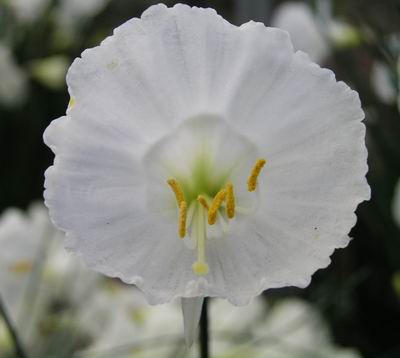
Narcissus flower ex plunge This beautiful narcissus flowering for the first time this year is one of these plunge-lings. It is quite similar to N. 'Camoro' but has a larger flower and a wider corona. It is at this stage that we lift them from the plunge and pot them up as this one is well worth bulking up. 
Narcissus ex plunge You can see that as well as a lovely flower it has a good root system and it is already showing signs that the bulb will increase well by splitting. As long as you handle the bulb carefully and give it a good watering in when you pot it up it will come to no harm from being uprooted in full growth. 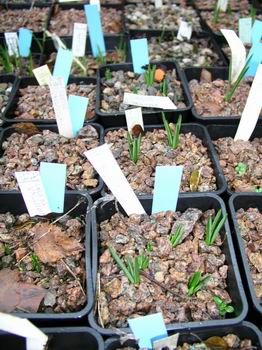
Crocus vallicola leaves In the outside frame the leaves of Crocus vallicola, which flowered some months ago, are just starting to appear. This is one of a group of crocus that grow at the edge of the melting snow where there is an ample supply of moisture in spring - we must therefore make sure that we provide them with plenty water if we want them to grow well in our gardens. 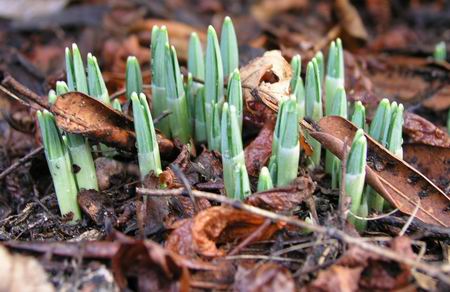
Galanthus leaves All over the garden Galanthus leaves are starting to poke through and it will not be long now until they come into flower. Have you ever looked at the tips of their leaves? Notice that thickened yellow tip. Is this nature's version of the tungsten-tipped drill ? As these early growing bulbs often have to push their way up through hard and frozen ground such a hard "drill-bit" would be a positive advantage. 
Narcissus & tulip leaf tips Some of the early narcissus have similar leaf tips and the leaves of Tulipa saxitalis (above right) show a different approach to the strengthening of the points of their leaves. 
Ipheion 'Froyle Mill' Under glass the flowers on Ipheion uniflorum 'Froyle Mill' are already in the advanced bud stage awaiting a warm enough day to open - they will have to wait a while as even though we are having a mild winter the sun does not rise high enough in the sky to raise the temperature sufficiently. We have to revert to taking plants into the kitchen for a day or two to get them to open their flowers. Tony Goode asked in the bulb log feed back if we would photograph the Crocus biflorus ssp tauri (shown in the last log) when it opened its flowers. 
Crocus biflorus ssp tauri We do not bring the crocus inside just to open their flowers but also to help the pollen ripen so that we stand a better chance of getting seed from these early flowering species. (Yes, Tony, I will tickle it as soon as the pollen flows !) Giving them a few days at temperatures of 10 to 15 degrees C greatly increases the amount of seed that we can harvest. ^ back to the top ^ |